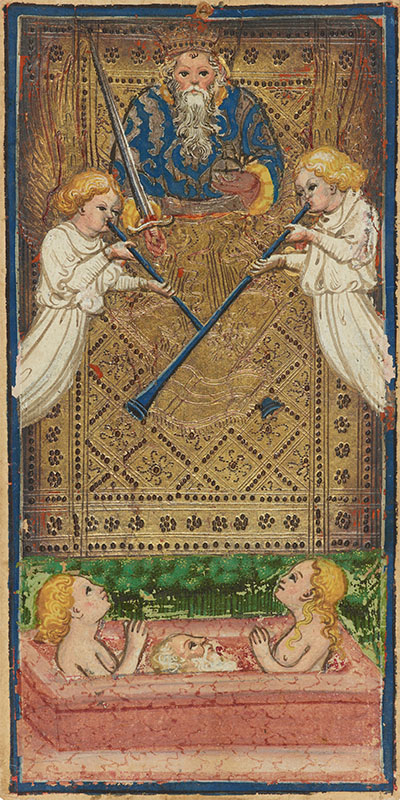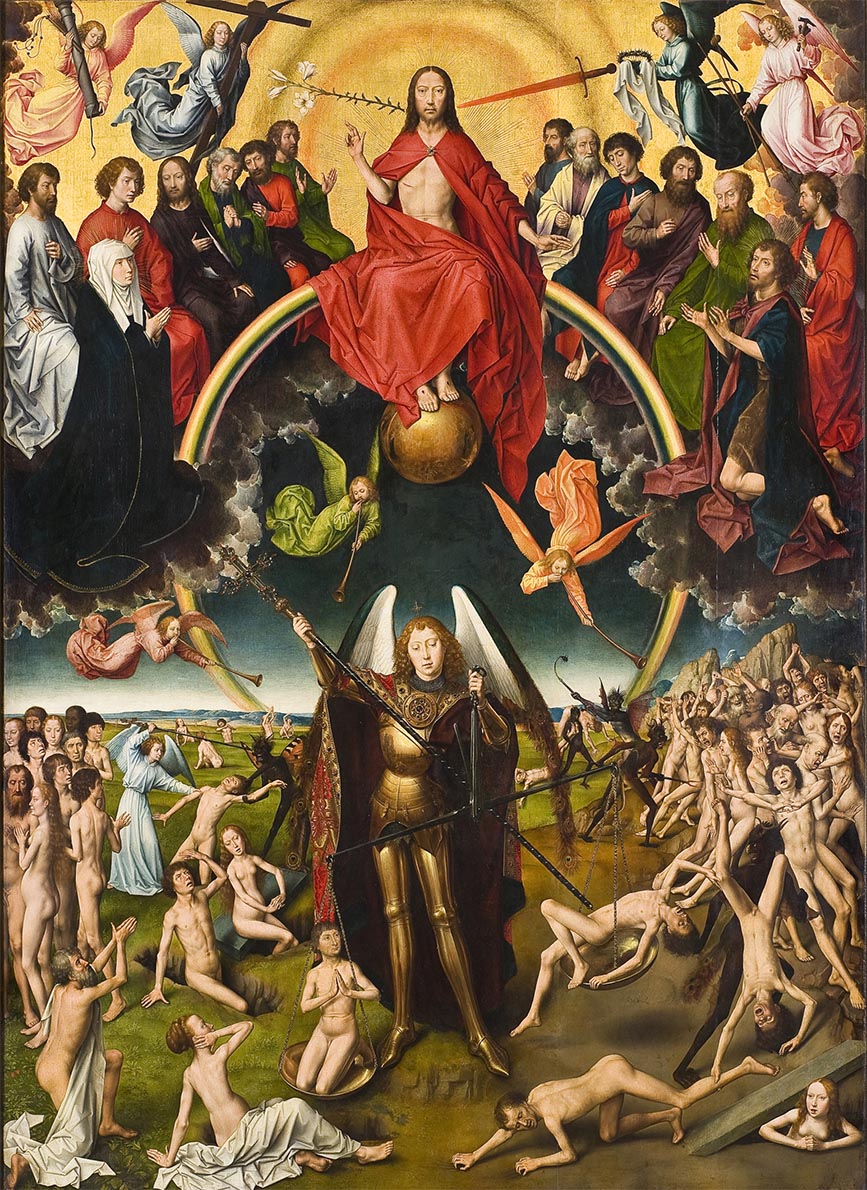THE TAROT WHEEL
THE LAST JUDGEMENT
Like Justice rules our world, the Last Judgement rules our lives. You can escape to world's Justice, but you cannot escape to God's Justice. The Last Judgement was portrayed on many artworks in the Middle Ages and Renaissance. Hereunder a detail of the interpretation by Hans Memling, a German painter, who realized this painting around 1470.
On the card, we see two angels who are calling the Death for Judgement. On the trumpets of the angels are fixed two standards, one with a cross, representing the sacrifice of Jesus, and a smaller one with the radiant Sun, symbol of the Visconti family. Behind the angels, we see God himself. Like on the card of Justice, he also has the Sword of Justice in his right hand. In his left hand an orb representing the Earth surmounted by a cross. On his head, a crown. The colors of his cloths are royal, blue on the outside and yellow on the inside
Conclusion of the deck with 14 Trionfi
To summarize, the first level of the Visconti Sforza is depicting the Estates of the Realm, the division of Society in three levels :
On the first level, figure the Commoners, represented by a Fool and a Conjurer.
On the second level, we have the Nobility, represented by the Empress and the Emperor. Being a woman, the Empress represents our family and the Emperor stands for the authorities.
On the highest level, we find the Clergy, represented by the Popess and the Pope. The Popess corresponds to Religion itself, and the Pope symbolizes the institute of the Roman Catholic Church.
Above the structure of Society we have Lady Justice who will act without distinction on everybody. Poor or rich, beggar, king or pope, everybody who commits a crime will have to respond to Justice.
The second group of seven cards is showing the Soul's Journey through life, influenced on his way by the three blind powers Love, Fortune and Justice. The three levels are:
Self control, represented by the victory over your desires, be it sexual (Love) or luxury and power (the Chariot). The Journey of the Soul encounters here its first major obstacle, the first blind power, Love.
Time, represented by the Lady Fortune turning the Wheel of time and by Father Time holding the hourglass, representing the temporal nature of our life. The second blind power, Fortune, is a big obstacle in this part of the Journey of the Soul.
Transition, represented by a big misfortune (the Hanged Man) and by Death himself.
Leading the structure of this group, we'll find the last Judgment, representing the Justice of God. Those who escaped Justice on Earth will not escape Justice in Heaven.
As a conclusion of this section, we can state that the 14 Trump structure was a logical and coherent structure, covering all aspects of human life. But the development of the Trionfi deck did not stop her. In 1460, Ercole I came back to Ferrara from Naples where he has had at the Neapolitan court, a complete education in art, culture, warfare, to be short, everything a future leader needs to know. Being confronted with the Trionfi decks since an early age, he had probably discussed a lot with other noblemen about the structure, and maybe as a result there was a reflection about changing the structure. Every aspect of life was present in the 14 trump structure, but for the Italian nobility, who were, in general, very religious, there was something important missing: the Afterlife. The Florentine writer Dante Alighieri had made a very detailed description of Heaven and Hell in his famous Divina Commedia, and even the poem I Trionfi had his triumph of Eternity. So, why not having Afterlife incorporated in the Tarot Trumps? In that way, the human life cycle, expressed in the trump cards, would really become complete. After the next page, still dealing with the structure of the Visconti-Sforza cards, we will see in the pages about the Ferarese Este decks how the Trionfi decks developed from 14 to 22 trumps.



